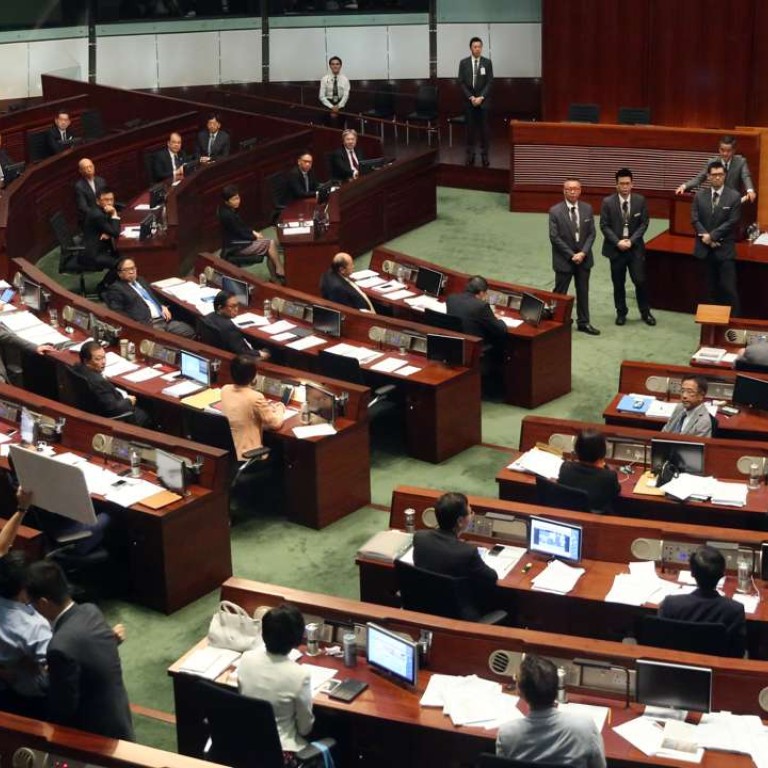
Explained: how Hong Kong’s Legislative Council has evolved
From its establishment in 1843 to its move to Tamar in 2011, Legco has been home to groundbreaking change and spirited debate
Hong Kong’s legislative chamber has come a long way, considerably expanding its influence from the days when it had just three members to now being served by 70 lawmakers holding highly divergent political views.
■ Hong Kong established as a British colony on January 26, 1841.
■ Hong Kong’s first constitution – entitled the Charter of the Colony of Hong Kong and established in the form of Queen Victoria’s Letters Patent – set up the first Legislative Council on June 26, 1843.
■ The first Legco meeting was held on January 11, 1844, in the former French Mission Building. It had only three official members, including governor Sir Henry Pottinger, who was council president and member. The chamber’s first ordinance, the Slavery Ordinance prohibiting slavery, was passed on February 28, 1844.
■ The first Standing Orders and Rules for Legco were adopted on March 7, 1845 – a precursor to today’s Rules of Procedure.
Watch: Hong Kong’s Legco elections explained
■ The first two unofficial Legco members were appointed on June 14, 1850, as a way to broaden community representation in the chamber.
■ The first unofficial Chinese member, Ng Choy, was appointed to Legco in 1880.
■ Law-making powers were handed down to Legco in 1888 when the Letters Patent was amended, requiring the governor to seek the consent, not just the advice, of the chamber when enacting laws.
■ The first unofficial female Legco member, Ellen Li Shu-pui, was appointed in 1965.
■ Chinese was used for the first time in Legco, with simultaneous interpretation, on October 18, 1972.

■ The former Supreme Court building, built in 1912, was converted into a permanent home for Legco on October 30, 1985, which had previously been meeting in the main wing of government headquarters.
■ For the first time, on October 30, 1985, 24 members of Legco were returned by indirect elections. Twelve were returned by 12 electoral college constituencies – comprising members of District Boards, Urban Council and the Provisional Regional Council. The other 12 were returned by functional constituencies made up of various professions.
■ 1991 marked the first time in the city’s history Legco members were returned by direct elections. Eighteen members were elected by the public in nine geographical constituencies. Emily Lau Wai-hing was the first female legislator to be directly elected.

■ In 1992, Chris Patten was appointed the last governor of Hong Kong. He embarked on a process of electoral reform to broaden representation in Legco, specifically by expanding the number of geographical constituency seats and vastly increasing the voter base of the functional constituencies.
■ The first – and last in the colonial era – “fully-elected” Legco served in 1995. Among the 60 members, 30 were from functional constituencies, 20 were returned by direct elections in geographical constituencies, and 10 were elected by the election committee constituency. Due to Patten’s electoral reforms in the functional constituencies – and to the dismay of Beijing – 2.7 million voters were eligible to cast a ballot in the functional constituencies, giving it the widest representation it had ever had.

■ A decade before the 1997 handover of Hong Kong from the UK to the central government, a “through-train” Legco was agreed upon. This would see the chamber that was elected in 1995 continue to serve through the handover and until the next election. However, Patten’s reforms derailed those plans. The Chinese government saw Patten’s plans as an attempt to allow pan-democrats to win and represent British interests in Legco post-handover. In response, Beijing set up a Provisional Legislative Council to safeguard its interests. Sixty members were elected by a 400-member selection committee on December 21, 1996. Hong Kong’s first chief executive, Tung Chee-hwa, was elected on the same day.
■ The first meeting of the Provisional Legislative Council convened on January 25, 1997, in the Shenzhen Guesthouse Hotel in Shenzhen, to elect its first president, Rita Fan Hsu Lai-tai. She was also the first woman to hold the office.

■ The Provisional Legislative Council operated from July 1, 1997 to July 2, 1998. The Legco elected in 1995 was dissolved on July 1, 1997. Elections for the first post-colonial Legco were held on May 24, 1998.
■ Since 1998, Legco has been dominated by two camps, parties or independents identified as being either pro-democracy or pro-Beijing.
■ A landslide victory for the pan-democrats was expected in the 2004 Legco elections due to an historic protest a year earlier against Article 23 legislation. However, pan-democrats only managed to add four seats to the total they secured in 2000.
■ The size of the number of geographical constituency legislators increased in subsequent Legco sessions: from 20 in 1998, to 24 in 2000, to 30 in 2004.

■ An electoral reform package was passed on June 25, 2010, increasing the size of the legislature to 70 members by adding five geographical constituencies and five functional constituencies. Hopefuls for the five functional constituency seats were to be elected district councillors and eligible to run by being elected by district council members. The winners were then to be elected by Hong Kong’s entire voter base. The seats are called “super seats” as candidates stand for election before a large number of voters and hence command a more significant mandate than other Legco members.
■ Legco relocated to the Legislative Council Complex at Tamar in October 2011.

